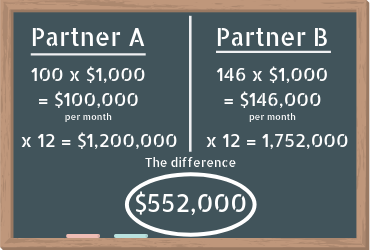Let’s step back to middle school math and make a simple equation out of it. Partner A does not use buyer personas and generates, on average, 100 leads per month via their marketing efforts. Partner B, who has put in the effort to develop buyer personas based on their customer data, on average, generates 146 leads per month. And let’s say that the average deal size for both partners is $1,000. At the end of one year, Partner B will have generated about $552,000 in SQL more than Partner A.

1. Who are my customers? Are they C-Level executives? Or are they IT professionals who have the authority to make decisions? What are their typical titles? Is one person the decision-maker or is there a team?
2. What do they care about? What are they measured on / what are their KPIs? What challenges do my solutions solve for them?
3. What platforms are they using / where are they consuming content? Do we see them interact with our brand mostly via clicks in email or are they engaging with us on social media?
4. What objections do my sales team typically hear from them?
Once you’ve collected all of this information, you can start to build out your personas for different types of buyers. Start with the most common decision maker and work your way down from there. It is helpful to identify trends among customers of the same seniority level and establish where and how they interact with your brand the most and include this in your personas. This will help you in the future when developing campaigns because you will know where to reach them. It is also helpful to include keywords that your customers care about in your personas. When creating campaigns, you can reference back to these keywords to develop your messaging.
This document is for your benefit and for the benefit of future marketers at your company. Once you have it created, it should be fairly simple to go back and update as you identify future trends among your customers. Your document doesn’t have to be perfect or pretty. It is more important that the content in the document is useful and beneficial than the layout is appealing. Consider making an Excel document with tabs for each persona or a PowerPoint with one or two slides per persona. However you choose to lay it out, make it your own and have some fun with it!
After you have identified all that great data from your buyer personas, you can use them to create very targeted campaigns. Nurture streams can be planned out to include the types of content that your personas are interested in and ad placements can be made strategically where your customers and prospects will be most likely to see them. You will be able to properly message to your personas around their pain points and educate them on solutions that can solve the problems they are experiencing. All of this this together should lead to the end result of more quality leads generated.
Are you using personas in your marketing? We’d love to hear about how you leverage them to target your message and make sure the right people are hearing it. Leave a comment below and let us know!

